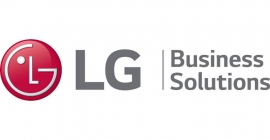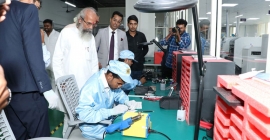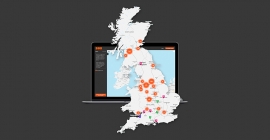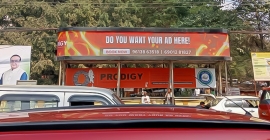Green printing is an imperative for OOH business
By Bhawana Anand - August 24, 2017
Leading digital printing firms assert the importance of adopting green printing machines, media and materials but call for a multi-stakeholder approach to ensure that green printing becomes an industry norm
The digital printing industry that caters to the OOH advertising business has been taking calibrated steps to make the practices greener, safer and cleaner. The shift to UV printing technology was one such step. However, is that the most definitive move to usher in green printing? The consensual view that emerges is that much more needs to be done on this count.
Large format green printing accounts for barely 1%-2% of all printing for OOH. There are apparently no more than 25-30 large format (3mts and above) green printing machines in business
In addition, more than 1lakh metric tonnes of PVC and Composite PVC are being utilised at present in India for OOH applications and a large portion of that is non-recyclable. So, OOH advertising is far from being eco-friendly.
The Green agenda needs focused attention
 As the demand for climate change mitigation gathers steam, every industry will be called upon to demonstrate the steps taken to further the green agenda. “With climate change becoming more evident with each passing second, and the problems that India (esp. Bangalore) is facing in disposal of non-recyclable plastic materials, I think it is inevitable that adopting green practice is sooner or later going to transition from a “trend” to a “mandate”. And the second point is that this transition is going to occur regardless of current profitability. In order to improve our margins and take up a significant piece of the green-printing pie tomorrow, it is imperative that we equip ourselves with the necessary resources today,” says Bhagawath Prasad, MD, Printech Digital Imaging.
As the demand for climate change mitigation gathers steam, every industry will be called upon to demonstrate the steps taken to further the green agenda. “With climate change becoming more evident with each passing second, and the problems that India (esp. Bangalore) is facing in disposal of non-recyclable plastic materials, I think it is inevitable that adopting green practice is sooner or later going to transition from a “trend” to a “mandate”. And the second point is that this transition is going to occur regardless of current profitability. In order to improve our margins and take up a significant piece of the green-printing pie tomorrow, it is imperative that we equip ourselves with the necessary resources today,” says Bhagawath Prasad, MD, Printech Digital Imaging.
 “Indeed, PVC used in any form is harmful and it should be put on notice on priority. The OOH industryuses ahuge quantity of PVC, but there are other industries as well that are using PVC/plastic ten times more than the OOH industry. Therefore, there is a strong need to control use of PVC in any form and in any industry,” says Mansukh Gala, Director, Pacific Digital.
“Indeed, PVC used in any form is harmful and it should be put on notice on priority. The OOH industryuses ahuge quantity of PVC, but there are other industries as well that are using PVC/plastic ten times more than the OOH industry. Therefore, there is a strong need to control use of PVC in any form and in any industry,” says Mansukh Gala, Director, Pacific Digital.
Incremental changes not enough
As they say the grass is always green on the other side. But if you flip any side of OOH there is a negligible amount of green printing happening. Barely 1%-2% of all printing for OOH can be termed as green, and those are also planned for places like malls and airports.
 Vivek Jejapal, Owner, Splash Digital, explains, “Talking about green printing, it is only a gimmick to sell. UV ink itself contains some amount of chemicals, so it is not entirely green. Another issue is UV printed on PVC flex is absolutely unfriendly as it is hard to dispose PVC, so saying we have a green printing existence wouldn’t be correct”.
Vivek Jejapal, Owner, Splash Digital, explains, “Talking about green printing, it is only a gimmick to sell. UV ink itself contains some amount of chemicals, so it is not entirely green. Another issue is UV printed on PVC flex is absolutely unfriendly as it is hard to dispose PVC, so saying we have a green printing existence wouldn’t be correct”.
Echoing this view, Naresh Kumar Dasari, Director, Macromedia Digital Imaging, says, “We use "Green Printing” but it is limited only to inks, whereas the substrates used still are plastics andplastic composites. Many of the plastics which we use for printing are non-recyclable”.
Wherein Sahil Mangla, Founder & Director, Sapphire Digital feels, “The enforcement of green technology will not help our industry, unless the clients buy into the concept. Ours is a client driven industry and corporate (brands) should adopt the technology.”
Several barriers to be overcome
Indeed, the entire industry understands and at the same time are trying to push this eco-friendly initiative but there are numerous challenges in establishing the green practice. Vinod Kumar Gupta, Director, Hannu Marketing explains, “There is an absolute lack of knowledge and awareness of this issue amongst the clients. They are not aware of the advantages and kind of possibilities available in India which restricts the use of green printing”.
“Anything “Green” is expensive, either Inks or media, at this moment as it is 60%- 70% more expensive than the current practices due to which most of the customers shun green printing. From an advertiser’s point of view the campaign message has to be delivered in a cost-effective manner and most of the customers are not willing to pay “more” for green printing. That’s why it never took-off,”says Naresh.
Prasad explains that fabric is one of the options available to further the green goals, but due to lack of standardisation of OOH format sizes -- where most of the billboards are huge -- the fabric can’t be seamed or stitched. Therefore, using green printing is restricted to smaller size billboard like 30’x15’ or 20’x10’. It can be used for street furniture and other small formats.
Equipment costs pose another big hurdle. Thegreen machines cost high and considering the negligible demand, the printers fear to invest huge amounts in sourcing out machines. Additionally, there is also a need to train the manpower to use such machines.
Government has a role cut out
While there have been initiatives in the past to press ahead with the green printing goals, Government intervention in the matter could help. Prasad, “Government can play a vital role in pushing green printing in India by providing some benefits to the users and producers. For instance, the government could offer some tax exemption or offer some incentives to people who opt for green printing. Otherwise the cost of investment is not justified in the current scenario.”
Naresh ideates, “Going Green will do a world of good to the environment.Both Government and the stake-holders should do their bit in this regard. Most importantly, clients / end-users should be educated about this problem and they should lead this from the front. As a service provider, we are more than willing to do our bit by investing in relevant technologies & materials”.
But as per Vinod, there should be a plan to promote green printing.“According to me the government can impose green printing in phases than at one go. For instance, they should start by giving mandates for using green printing at Metro stations, hospitals, railways and then followed by rest of the places,”he says.
Inspiration from the West
The West has taken strident steps in the realms of green printing and those could serve as useful references and benchmarks for the Indian industry. Sample these:
In many western countries, Poly Ethylene (PE) is being used as Base Substrate for OOH display. PE is recyclable and it can only be printed using UV Inks. Most of the UV inks are "Green Guard” certified. Thus, shifting to this material (PE) solves a huge problem but due to cost constraints most of the clients / end users are not willing to take the plunge. The cost escalation from PVC to PE is about 60% to 70%.
In Europe, for many years Blue Back Paper was being used as a substrate but this material doesn’t suit Indian conditions as our OOH media is not built that way.
European countries and Canada have restricted the size of their billboards to 15 feet height so that fabric can be stitched on it.
UK & US has put complete ban on solvent printing.
A final word
The printing industry is waiting to see how soon all concerned stakeholders will take the green pathway. That would involve machine manufactures, to printers to agencies and finally the clients.
Prasad states, “Once, the first step of introducing green products to the clients is complete, I don’t think they would want to go back to low quality prints. Moreover, as the demand for a certain product rises, its cost will go down. Keeping that in mind, it’s only logical that OOH buyers go for more and more green products so that they themselves provide the incentive for the market to reduce the price of green printing. The onus to do this is now on the clients alone, and the incentive to take up the cause seriously by the clients must come from the government, as we at Printech are up and ready with the required technology and resources.”
Likewise, Naresh comments, “Currently, Green Certified materials and equipment are produced in limited quantity and hence expensive. But once people start using them regularly, the cost will invariably come down. The current Solvent Printing Technology was also very expensive when it started about 20+ years ago. Over the years, the price dropped significantly as more producers stepped in and we believe the same will happen with eco-friendly printing as well”.
Vinod adds, “I think it is our responsibility to ensure the safety of workers and employees involved in printing work including the people exposed to the materials. If the entire industry comes together to take this initiative forward, it will make a big impact”.
“It will take collective working by the machine manufactures, ink producers, media manufactures, agencies, facilitators like us and the client to drive this mission. I am personally of the opinion that outdoor being a large format and goes for mass printing, it will take a lot of effort and education of the brand custodians to get everyone on the same page -- effort and time because the perception is that green printing is expensive. I would suggest an idea like carbon credits given to organisations that shift to green digital printing,” says Sahil.
The current trends and viewpoints suggest that the printing dimension of OOH business will experience a major makeover in the coming times, and become the torchbearer for green practices. But for that to happen, all key stakeholders will have to take up green printing as a common cause.

Stay on top of OOH media trends







_140_270.jpg)



